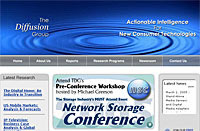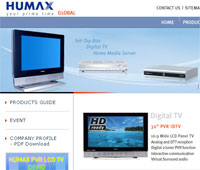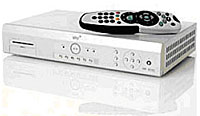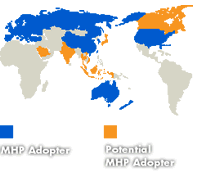 Evidence is beginning to amass that two of the most hyped products in the early digital home market will be lucky if they manage to reach niche market status in the next few years.
Evidence is beginning to amass that two of the most hyped products in the early digital home market will be lucky if they manage to reach niche market status in the next few years.
Not so long ago, people were getting very excited by media servers and digital media adapters. They were the future. And then, err, people kinda forgot about them.
So what happened?
According to new research from The Diffusion Group, it seems that despite the products being well-hyped, widely discussed and blessed with encouraging early forecasts from a number of research firms, the devices have suffered from extremely limited demand.
Moreover, the report concludes that demand for both these technologies will remain limited and that what unique functionality these solutions do offer will be quickly integrated into other platforms.
“It is not that this type of functionality is undesirable,” said Michael Greeson, President of The Diffusion Group. “The premise of networking stored digital media content to multiple devices in the home is valid, but consumers aren’t looking for separate devices to enable this experience.
Instead, the applications and benefits enabled by these two platforms will be increasingly integrated into devices with which consumers are more familiar – such as DVD players that are now evolving into DVD-recorders or set-top boxes with built-in hard-drives and integrated networking.”
“While media servers were originally positioned to be the hub of the digital home, demand for these solutions has never gotten off the ground.”
Although Windows Media Center PCs have proved more popular, Greeson asserts that this is simply down to normal PC replacement cycles rather than consumers finding anything particularly compelling about the concept.
Other media server platforms have been much less successful, although the push of high-end digital set-top boxes by cable and satellite video service providers offers a case for optimism.
“However,” says Greeson, “this is a push model, where the equipment is subsidised by the service provider in order to generate digital media service revenue, as opposed to a ‘pull’ model where consumers are so enamoured with the device that they run to the retail store to purchase one.”
When it comes to digital media adapters or DMAs, the Diffusion Group paints a gloomy picture.
Introduced a couple of years ago, the idea was to make it easy to share content from the PC to other media devices in the home, such as a TV or stereo using a DMA. But their techie-tastic appeal failed to win over punters.
“Not long ago, there were ten to fifteen companies offering DMAs,” said Gary Sasaki, a contributing analyst with The Diffusion Group and President of DIGDIA, a media consultancy.
“At this year’s CES, DMAs were hard to find. Part of the reason for the premature demise of DMAs is that their functionality appeals mostly to early-adopter or technology-savvy buyers. Additionally, and somewhat similar to media servers, the functionality of DMAs is slowly getting integrated into other more familiar product categories.”
The report suggests that we’ve got an industry in fast transition, with early, stand-alone technologies being picked clean for their useful ideas and then incorporated into more consumer-friendly converged products.
Diffusion Group
 Humax have dished out detailed information about their new dual-tuner, Freeview-enabled PVR, the PVR-9200T.
Humax have dished out detailed information about their new dual-tuner, Freeview-enabled PVR, the PVR-9200T. Receiving and recording of pay TV channels is possible through a special CA module.
Receiving and recording of pay TV channels is possible through a special CA module. There’s also a handy USB2.0 port provided for MPEG A/V file transfers between the Duovisio and a PC, letting users play back their digital photos or listen to MP3 files downloaded from a PC.
There’s also a handy USB2.0 port provided for MPEG A/V file transfers between the Duovisio and a PC, letting users play back their digital photos or listen to MP3 files downloaded from a PC. OpenTV Corp have given out a large toot on their PR trumpets and announced the availability of their “PVR 2.0” software to network operators and set-top box manufacturers worldwide.
OpenTV Corp have given out a large toot on their PR trumpets and announced the availability of their “PVR 2.0” software to network operators and set-top box manufacturers worldwide. PVR 2.0 is built upon OpenTV’s “Core 2.0” software, the fourth generation of set-top middleware which sports an architecture and features to support the expanding requirements of advanced digital television set-top boxes including PVR, VOD, IPTV, HDTV and home networking.
PVR 2.0 is built upon OpenTV’s “Core 2.0” software, the fourth generation of set-top middleware which sports an architecture and features to support the expanding requirements of advanced digital television set-top boxes including PVR, VOD, IPTV, HDTV and home networking.  “Network operators increasingly understand middleware’s value in achieving their business goals, reducing operational costs and improving time to market of the services critical to the success of their businesses,” said Tim Evard, who has a very big name badge declaring him to be OpenTV’s “senior vice president and general manager of products and marketing.”
“Network operators increasingly understand middleware’s value in achieving their business goals, reducing operational costs and improving time to market of the services critical to the success of their businesses,” said Tim Evard, who has a very big name badge declaring him to be OpenTV’s “senior vice president and general manager of products and marketing.” Frontier Silicon has launched a new module that claims to bring personal-video-recorder (PVR) like capabilities to DAB digital radio.
Frontier Silicon has launched a new module that claims to bring personal-video-recorder (PVR) like capabilities to DAB digital radio.  Recordings can be saved onto a memory card on the same radio or played back on any compatible audio unit.
Recordings can be saved onto a memory card on the same radio or played back on any compatible audio unit.  Frontier Silicon’s software provides an interface through which EPG and dynamic service information (DLS) can be viewed, with scrolling text allowing information ‘wider’ than the 16-character screen to be seen.
Frontier Silicon’s software provides an interface through which EPG and dynamic service information (DLS) can be viewed, with scrolling text allowing information ‘wider’ than the 16-character screen to be seen.  Across Europe, interactive services using the DVB Multimedia Home Platform (MHP) standard have been launched on cable, satellite and terrestrial platforms. While not formally mandated by the European Commission, MHP has been embraced as an open and interoperable standard that can be actively encouraged and promoted. Already, several countries have launched MHP-based interactive services on the terrestrial platform.
Across Europe, interactive services using the DVB Multimedia Home Platform (MHP) standard have been launched on cable, satellite and terrestrial platforms. While not formally mandated by the European Commission, MHP has been embraced as an open and interoperable standard that can be actively encouraged and promoted. Already, several countries have launched MHP-based interactive services on the terrestrial platform.  In Austria, a DTT trial with MHP-based interactive services provided 150 households in Graz with access to an interactive television service called !TV4 using the telephone connection for the return channel. Using their television remote control, viewers could retrieve information services and vote. Given the success of the trial, it is likely that MHP-based interactive services will be launched alongside DTT services.
In Austria, a DTT trial with MHP-based interactive services provided 150 households in Graz with access to an interactive television service called !TV4 using the telephone connection for the return channel. Using their television remote control, viewers could retrieve information services and vote. Given the success of the trial, it is likely that MHP-based interactive services will be launched alongside DTT services.  Of course MHP is not the only interactive television service system in the market. Proprietary systems such as MediaHighway and OpenTV have been installed in a large number of set-top boxes, often for cable and satellite platforms. In the United Kingdom, the MHEG standard is widely used on the terrestrial platform. As a result of the various products and services in the market, the DVB Project has been working on the development of the Portable Content Format (PCF) to deliver a wide range of interactive television services to multiple platforms with a minimum of re-authoring. It has significant interest for operators who wish to migrate towards MHP by allowing them to manage simultaneously a mixed population of devices.
Of course MHP is not the only interactive television service system in the market. Proprietary systems such as MediaHighway and OpenTV have been installed in a large number of set-top boxes, often for cable and satellite platforms. In the United Kingdom, the MHEG standard is widely used on the terrestrial platform. As a result of the various products and services in the market, the DVB Project has been working on the development of the Portable Content Format (PCF) to deliver a wide range of interactive television services to multiple platforms with a minimum of re-authoring. It has significant interest for operators who wish to migrate towards MHP by allowing them to manage simultaneously a mixed population of devices.  Pace Micro Technology, a cutting edge UK digital set-top box provider tasked with developing emerging technologies across all television platforms, has trumpeted the launch of a number of STB’s and PVR’s, including the Laguna DC551HD and DC 501 Chicago all-digital set-top box.
Pace Micro Technology, a cutting edge UK digital set-top box provider tasked with developing emerging technologies across all television platforms, has trumpeted the launch of a number of STB’s and PVR’s, including the Laguna DC551HD and DC 501 Chicago all-digital set-top box.  Pace is also offering the Tahoe DC775 HD-DVR, claiming it to be the most advanced high definition DVR for North America, and the first cable set-top box to offer features based on next generation silicon. Interestingly it offers a number of ways to save video content to the 160Gb hard drive – Standard Definition (SD), High Def (HD) and enhanced analogue. With multi-room video distribution and support for high-speed data connections for home computers, wireless routers and VoIP included you might be wondering what isn’t included.
Pace is also offering the Tahoe DC775 HD-DVR, claiming it to be the most advanced high definition DVR for North America, and the first cable set-top box to offer features based on next generation silicon. Interestingly it offers a number of ways to save video content to the 160Gb hard drive – Standard Definition (SD), High Def (HD) and enhanced analogue. With multi-room video distribution and support for high-speed data connections for home computers, wireless routers and VoIP included you might be wondering what isn’t included.  Pace Americas’ VP of Technology Chris Dinallo had clearly feasted on a diet of buzzwords before adding, “All-digital and digital simulcast are critical industry initiatives, and uniquely, Pace is proud to be the only set-top box provider that can support all-digital on both networks.”
Pace Americas’ VP of Technology Chris Dinallo had clearly feasted on a diet of buzzwords before adding, “All-digital and digital simulcast are critical industry initiatives, and uniquely, Pace is proud to be the only set-top box provider that can support all-digital on both networks.”  Samsung have jumped into bed with Digeo – a leading provider of media center software and services – and announced a deal to produce the next-generation Moxi II Media Center product family.
Samsung have jumped into bed with Digeo – a leading provider of media center software and services – and announced a deal to produce the next-generation Moxi II Media Center product family.  US cable companies Charter Communications and Adelphia are set to be the first two cable companies to start dishing out the boxes to customers.
US cable companies Charter Communications and Adelphia are set to be the first two cable companies to start dishing out the boxes to customers.  The cost-reducing chip will also offer improved graphics performance with Digeo cranking up the speed of the microprocessor from 733 megahertz to 1 gigahertz.
The cost-reducing chip will also offer improved graphics performance with Digeo cranking up the speed of the microprocessor from 733 megahertz to 1 gigahertz.  DVRs may well be the hot product in the home entertainment industry, but dusty old video cassettes still rule the roost in the US.
DVRs may well be the hot product in the home entertainment industry, but dusty old video cassettes still rule the roost in the US.  However, take up is still very low compared to many other consumer electronics products: just 6% of all US households have a DVR, compared to the 87% with a VCR, 60% with a DVD console and 12% with Video on Demand (VOD).
However, take up is still very low compared to many other consumer electronics products: just 6% of all US households have a DVR, compared to the 87% with a VCR, 60% with a DVD console and 12% with Video on Demand (VOD).  Evidence is beginning to amass that two of the most hyped products in the early digital home market will be lucky if they manage to reach niche market status in the next few years.
Evidence is beginning to amass that two of the most hyped products in the early digital home market will be lucky if they manage to reach niche market status in the next few years.  Rumours pointing at Apple as a potential bidder for TiVo have given the digital video recorder company’s shares a healthy boost – and got people wondering whether the deal would be a good fit.
Rumours pointing at Apple as a potential bidder for TiVo have given the digital video recorder company’s shares a healthy boost – and got people wondering whether the deal would be a good fit.  Nearly every media and technology company is aiming at the living room now, either with Media Centre-style PCs or other digital hubs to spread content such as video and music around the home.
Nearly every media and technology company is aiming at the living room now, either with Media Centre-style PCs or other digital hubs to spread content such as video and music around the home.  Digital civil liberties organisation, The Electronic Frontier Foundation (EFF) has announced the next stage in its ongoing challenge to the US Federal Communications Commission’s “Broadcast Flag” technology mandate (
Digital civil liberties organisation, The Electronic Frontier Foundation (EFF) has announced the next stage in its ongoing challenge to the US Federal Communications Commission’s “Broadcast Flag” technology mandate (